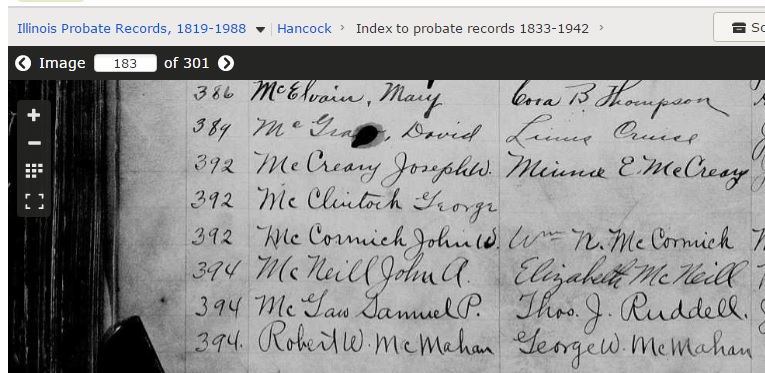After writing the post about the 1914 purchase of property in Elvaston, Hancock County, Illinois, by John Habben from the estate of Samuel P. McGaw, I decided to try and find some record of the sale online.
I knew the Hancock County property deeds were not available online, but the probate databases at Ancestry.com does contain (or is supposed to contain) digital versions of the microfilmed copies of probate records for Hancock County, Illinois. These records are supposed to contain copies of the probate packets through the early 20th century. The goal was to find Samuel McGaw’s probate packet and search it for some reference to the sale of his home in Elvaston to the Habbens. The actual deed would be ideal, but at that exact moment I was limited to what I could find online.
The index to Illinois probate materials at Ancestry.com contained two references to Samuel McGaw’s estate, but both were to journal entries in the court journals regarding his estate. Interesting, but not what I wanted. The casefile would contain more information. There was no index entry for Samuel McGaw’s packet of court papers in Ancestry.com’s index. That was odd given that McGaw’s probate appeared in two of the journals.
I knew that FamilySearch had digitized some probate records for Hancock County, Illinois–including the index actually maintained by the local court. Having used that index onsite numerous times, I knew it was the way to go. The problem was that while FamilySearch had digitized the probate index and most of the microfilmed copies of the probate ledgers and journals, they have not digitized the microfilmed copies of the case files. Those were the files I really wanted.
The probate index online at FamilySearch contained a reference to Samuel P. McGaw’s estate. It also indicated that there was a casefile for his estate (number 394 as shown in the illustration of part of the index page). I was not surprised that Samuel’s estate had a packet of papers. It is highly unusual for a probate in this county to not have one. 
I searched Ancestry.com‘s index to probates for probates in case file 394 and there was no entry for a name remotely related to Samuel P. McGaw. There was not time for me to manually view the entire set of files from physical box 394 online, so I happened to view one that was for a distant relative by marriage: Nancy Agnes Harper.
Interestingly enough there were a few images from Samuel P. McGaw’s estate intermingled with the images for Nancy’s estate. The few images did not constitute a typical file and there was no “cover sheet.” I reviewed the rest of the pages in Nancy’s file for additional McGaw references, but found none. In the interest of time I did only randomly viewed images from the rest of the set of images in which Nancy’s probate appeared. I did not view each and every image.
My options at this point are:
- view the entire microfilm–the actual microfilm. There are two reasons for this. One is that it is faster for me personally to view microfilm that digital images. Two is that I’m concerned there may have been some irregularity with how Ancestry.com digitized the microfilmed images of these records they received from FamilySearch.
- view the actual packet of papers–the real deal. The reason for this is that it’s possible FamilySearch neglected to film McGaw’s packet of papers or that it was missing when filming was done.
I have a theory on what happened, but until the options above have been completed, I’m not going to publicly speculate.
A few quick lessons from this little experience:
- Track how you search a database, especially when your search is unsuccessful.
- Clearly cite the database you are using to access the records. In this case, I used Ancestry.com and FamilySearch. I cannot just say I used “Hancock County, Illinois, probate records.” Ancestry.com‘s digital version differs from FamilySearch‘s digital version (and then there’s what’s on microfilm–so a reference to FamilySearch for these records needs to make clear if I used the digital version or the microfilm version). And both of those versions are not as complete as the actual records at the courthouse. This is why clear citation matters.
- Learn about the actual records. If you take what Ancestry.com or FamilySearch serves up to you at face value and don’t question if there could be inadvertant omissions of individual documents, files that were accidentally not reproduced, or complete sets of records not included, then you could be missing out. It helps greatly to be familiar with how the records were created, how they were indexed, and how they are stored.
The actual deed is the best documentation for this sale. I was just hoping out of curiosity to find something about it in the probate packet.
It wasn’t supposed to turn into a genealogical adventure.